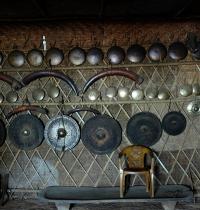Zubeni Lotha
Grant Period: Over one year and six months
This grant supports Zubeni Lotha to study and understand the construction of identity and representation of the Konyak Nagas by looking specifically at the photographs taken by the Austrian ethnologist Christoph Von Fürer-Haimendorf in 1936. Her entry into this project is rooted in her practice as a photographer who is keen to look at the larger tradition of colonial-anthropological photography through which the Naga community has been defined.
In 1936 ethnologist Christoph Von Fürer-Haimendorf entered Nagaland with a tool (camera) that would transmit the earliest and most definitive images of the Konyak people to the rest of the world. Subsequently, Haimendorf, in his book Naked Nagas, presented to the reader, alongside the photographic representations of men and women, both dressed and undressed, vivid accounts of the people he photographed. When read in conjunction with the photographs, his descriptions provide insight into his gaze and the relationship he had with the subjects of his photographs. His descriptions record his daily observations of the social life of the Konyak Nagas, as well as his thoughts on photography, its process and aesthetics, and the choice of his subjects. The emphasis on documenting the ‘primitive’ and ‘traditional’ ways of life is evident in his photographs.
Through this project Zubeni aims to study Haimendorf’s work, reinterpret his images in the present, and explore the ways in which the agency of the people that Haimendorf photographed could be understood. Since at that point of time, this was a society where the difference in the consciousness of the body as naked and as covered did not exist, Zubeni will explore the photographic encounter that could have resulted in how people began to see themselves through those lenses. This would lead to understanding their self perceptions at the present, within the larger discourse of their cultural history, which has been widely studied and commented upon.
In order to do this, she will study the complete oeuvre of Haimendorf’s photography looking at the framing of subjects and objects, the materiality of the images, the period of history that the photographs represent, and the colonial-political context which allowed for the creation of these images. In the course of visiting the Konyak areas where Haimendorf based his work, Zubeni will interact with the people and seek their opinions/readings of Haimendorf’s photographs to discern their reactions about themselves and their culture. In addition, she will take portraits of people in these areas directly referencing Haimendorf’s images with her own photographs. For instance, she may photograph people holding the old photographs against themselves and shoot them against a plain background. The choice of portraiture as a shooting method is significant for her, in order to question Haimendorf’s method of framing. She will record her personal experiences and the process of photographing the Konyaks.
She hopes to build a dialogue around representation and stereotype that can be forged through the encounter between Haimendorf’s images, her interpretations of them and the ones she takes herself. Her aim is to frame a critique of the pressure exerted by the images of Nagas crystallised in Haimendorf’s work and propagated by the state machinery for tourism. She aspires to enquire into possible alternative ways of looking at and seeing the Nagas, devoid of this exoticism and whether photography could be an apparatus for developing that perspective.
Programmatically, the decision to support this project is embedded in IFA’s mandate to support practitioners who are interested in undertaking research to investigate marginalised or relatively unexplored areas; and create spaces for dialogue between theory and practice by offering new readings/frameworks of artistic practices. The outcome of this project will be an exhibition.
This grant was made possible with support from Titan Company Limited.




